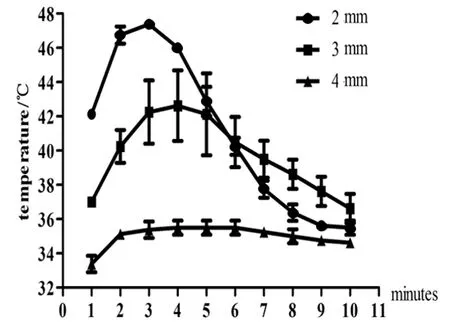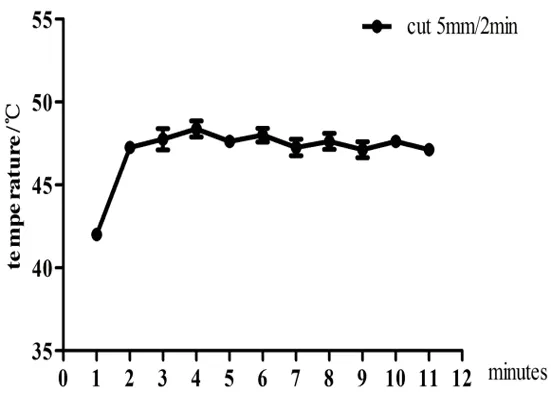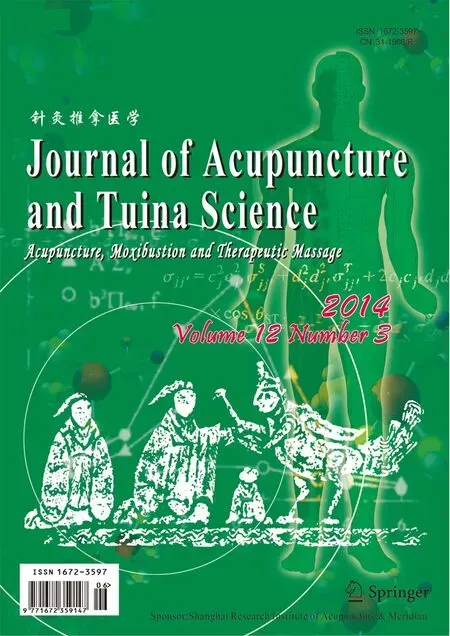Study on Burning Temperature Versus Time Graph of Moxa Sticks in a Novel Animal Moxibustion Device
Zhou Jun-mei, Wei Fang2, Liu Su-jun, Zhang Bi-meng
1 Department of Acupuncture and Moxibustion, Shanghai First People’s Hospital, Shanghai Jiaotong University School of Medicine, Shanghai 200080, China
2 Department of Central Lab, Shanghai First People’s Hospital, Shanghai Jiaotong University School of Medicine, Shanghai 201620, China
ACUPUNCTURE-MOXIBUSTION APPARATUS
Study on Burning Temperature Versus Time Graph of Moxa Sticks in a Novel Animal Moxibustion Device
Zhou Jun-mei1, Wei Fang2, Liu Su-jun1, Zhang Bi-meng1
1 Department of Acupuncture and Moxibustion, Shanghai First People’s Hospital, Shanghai Jiaotong University School of Medicine, Shanghai 200080, China
2 Department of Central Lab, Shanghai First People’s Hospital, Shanghai Jiaotong University School of Medicine, Shanghai 201620, China
Author: Zhou Jun-mei, master degree candidate
Objective: To invent a novel animal experimentation moxa device and intend to solve temperature fluctuations during moxa stick burning in animal moxibustion test.
Methods: Smokeless moxa sticks of 4 mm in diameter and 120 mm in length were selected in this trial. The target temperature was (47±1) ℃. The burning temperature versus time graph of moxa sticks during un-interfered time period were recorded when the distances between moxa sticks and thermometer were 2 mm, 3 mm and 4 mm respectively. In addition, the total lengths of burned moxa stick ashes within 0-5 min were recorded. Then the moxa stick burning temperature versus time graph after intervention was measured.
Results: The maximum temperatures during test duration when the distances were 2 mm, 3 mm and 4 mm were (47.37±0.25) ℃, (42.62±2.05) ℃ and (35.50±0.40)respectively; the total lengths of burned ashes from 0-5 min were (5.1±0.08) mm, (12.17±0.44) mm, (14.8±0.31) mm, (17.25±0.17) mm and (19.82±0.67) mm respectively; with a distance of 2 mm between a moxa stick and the testing area, remove 5 mm ashes every 2 min, then the maximum and minimum temperatures within 10 min were (48.37±0.47)and (47.12±0.25)showing no statistical significance (P=0.12).
Conclusion: The novel animal experimentation moxa device can help to maintain relatively constant moxa stick burning temperature during test period.
Moxibustion Therapy; Moxa Stick Moxibustion; Animal Experimentation;Instrumentation
Moxibustion is one of the important therapies in Chinese medicine. Studies have suggested that thermal effect plays a major role in therapeutic efficacy of moxibustion[1-3]. What’s more, numerous studies have indicated that thermotherapy may become a method for cancer treatment[4-6]. The mechanism might be associated with the fact that temperature of >43℃can activate transient receptor potential (TRP)[7-8]. Due to fluctuation of burning temperatures during treatment, different thermal stimulation may affect the therapeutic effect[9-10]. However burning temperatures of moxa stick were not well controlled in many animal moxibustion experiments. This may result in poor repeatability and controversial in moxibustion effect. It’s important to maintain an effective treatment temperature. Through continuous practice and improvement, our research team has developed a novel laboratory animal moxibustion device (the patent number: 201320719089.8) to minimize animal moxibustion experiment error fromtemperature control and animal fixation. Using (47±1)as the targeted temperature, this experiment used smokeless moxa sticks of 4 mm in diameter and 120 mm in length (manufactured by Nanyang Hanyi Moxa Co., Ltd.) for moxibustion. The operation procedures of this device were explained as follows.
1 Materials and Methods
1.1 Moxibustion device
This device works in temperature control and animal fixation to minimize the possible error in animal moxibustion test: fluctuation of burning temperature of moxa sticks and struggle of experimental animals. The device consists of wood and iron nails: wood particle (1), screw thread hollow rods (2), wooden frames (3), thermal insulation slices (3) and shelves with a support base (5). The wood particle (1) was placed on the top of the shelves (5). The screw thread hollow rods (2) was set to match holes in the thermal insulation slices (4) perpendicularly through the top layer of the shelves (5) and the wooden frame (3) was placed to the support base of shelves (5), (Figure 1).
During experiment, the wood particle (1) can be either increased or decreased. By decreasing one wood particle, the distance between moxa stick and experimental animal would be increased by 0.5 cm. Other than immobilizing moxa sticks, the inner thread interval of screw thread hollow rod (2) was 0.1 cm. By rotating down one circle, the distance between moxa stick and experimental animal would be increased by 0.1 cm. By rotating of 180°, the distance between moxa stick and experimental animal would be increased by 0.05 cm. During experiment, burnt ashes could be removed and the distance between moxa stick and moxibustion area can be accurately adjusted through the coarse and fine adjustment design. The wooden frames (3) and thermal insulation slices (4) were used for animal fixation and round holes in the thermal insulation slice allowed for heat conduction.

Figure 1. Device design drawing for animal moxibustion
1.2 Moxa stick
Smokeless moxa sticks (4 mm in diameter and 120 mm in length) used in this experiment were manufactured by Nanyang Hanyi Moxa Co., Ltd. (the patent number: 20083008127.4).
1.3 Experimental method and observation indexes
The laboratory temperature was 26-28℃(controlled by central air conditioning) and the relative humidity was 25%-28%. There was no apparent air flow in the room. Moxa stick was immobilized and its height was adjusted to match with the holes in the thermal insulation slice. The thermometer was placed under the round hole of the thermal insulation slice.
Using (47±1) ℃ as the target temperature, the moxa stick temperatures at different time periods were recorded. During experiment, the burning temperature versus time graph was recorded at the distance of 2 mm, 3 mm and 4 mm without removal of burnt ashes. Also recorded were accumulated lengths of burnt ashes of moxa stick within 0-5 min and burning temperature-time graph after removal of burnt ashes.
1.4 Statistical method
The SPSS 19.0 version statistical software was used for statistical analyses. The measurement data was expressed asThet-test was used for the comparison of the measurement data and for the inter-group comparison of parameters with normal distribution. The one-way analysis of variance was used for comparison among three or more groups, with a sample sizeα=0. 05.
2 Experimental Results
2.1 Burning temperature versus time graph without removal of burned ashes of moxa sticks
The burning temperature versus time graphs (Figure 2) were recorded using a thermometer when the distances between moxa stick and testing area were 2 mm, 3 mm and 4 mm respectively. The recorded maximum temperatures at above corresponding distances were (47.37±0.25) ℃, (42.62±2.05) ℃ and (35.50±0.40) ℃ respectively. The maximum temperature at a 2 mm distance was significantly higher than that at a 4 mm distance (P=0.00) but had no significant difference with that at a 3mm distance (P=0.79). This indicates that required experimental temperature could not be achieved at a 4 mm distance.
2.2 Accumulated burnt ashes within 0-5 min
Considering that burnt ashes can impede heat conduction, we measured the accumulated asheslength within 0-5 min during moxa stick burning (Figure 3).
The accumulated lengths of burnt ashes at 1 min, 2 min, 3 min, 4 min and 5 min were (5.10±0.08) mm, (12.17±0.44) mm, (14.80±0.31) mm, (17.25±0.17) mm and (19.82±0.67) mm respectively. From 2-5 min, the ashes increase by approximately 2.5 mm/min.

Figure 2. Burning time versus temperature graph without removal of burned ashes of moxa stick

Figure 3. The accumulated length of burned ashes within 0-5 min of moxa stick burning
2.3 Burning time versus temperature graph after removal of burnt ashes
The burning temperature versus time graph after removal of burnt ashes every 2 min at a 2 mm distance between moxa stick and testing area was recorded (Figure 4).
Since it took approximately 1 min to reach the temperature of 42 ℃, the trial time started 1 min after burning the moxa stick, for 10 min successively. After removal of 5 mm ashes every 2 min, the maximum and minimum temperatures within 10 min were (48.37±0.47) ℃ and (47.12±0.25) ℃respectively, showing no statistical significance (P=0.12).

Figure 4. Moxa stick burning time versus temperature graph after removal of burned ashes
3 Discussion
Results of three tests have suggested that this moxa device can help to maintain constant burning temperature of moxa sticks during test period. Using (47±1)as the target temperature in this trial, the distance between moxa stick and testing area was kept 2 mm. Then 5 mm long ashes was removed every 2 min. Thanks to its coarse and fine adjustment design, this device can adjust the distance between moxa stick and testing area in a fast and accurate way, thus maintaining a constant temperature of the testing area.
Today, tumor has become a major challenge. Due to toxic and side effects brought about by radio- or chemotherapy, more and more tumor patients turned to alternative therapies such as thermal therapy, small-molecule targeted therapy, biological agents and acupuncture[11-14]. Modern studies have indicated that the therapeutic efficacy of moxibustion is associated with its thermal effect, moxa combustion products, photo-radiation effect and meridians[3,15-17]. Du GZ, et al[18]have found that temperature change curves of moxa cones include phases of slow rise, rapid rise, rapid drop and slow drop. Lim J, et al[19]have reported that maximum temperatures of direct or indirect moxibustion are significantly higher than the minimum temperature (P=0.00). This experiment has also found a significant fluctuation of burning temperatures of moxa sticks (P=0.00). This device is intended to use in moxibustion for tumor animal models. Our purpose is to better adjust the temperature of testing area during moxa stick burning and fixation of animals and thus to increase the reliability of therapeutic efficacy. Temperature sensation of mammals depends on sensor of transient receptor potential (TRP) family of ion channels, especially the transient receptor potential vanilloid 1 (TPRV1): the highly heat-sensitive voltage gate. WangGY, et al[20]have found that cholesterol level of cases in the 46℃ moxibustion (treatment) group was significantly lower than that in the 38 ℃moxibustion (control) group. This might be associated with a substantially higher TPRV1 mRNA expression in the treatment group. However, it’s not the case that higher temperature gets better effect. Studies have shown that temperature >44℃ can damage tissues. Also, the risk of cell injury and protein denaturation increases with temperature elevation[4,21]. Other studies have suggested that at the moxibustion temperature of 46-48 ℃, a linear growth occurs in activation reaction of subnucleus reticularis dorsalis (SRD) neuron; and temperature <42℃ had no activation on SRD neuron[22]. This indicates that temperature is closely associated with the therapeutic efficacy of moxibustion and moxibustion temperature therefore needs to be well controlled during treatment.
Conflict of Interest
The authors declared that there was no conflict of interest in this article.
Acknowledgments
This work was supported by Special Project for Laboratory Animals, Shanghai Municipal Science and Technology Commission (No.11140900902).
[1] Bai YH, Lin WR. Study on relationship of moxibustion and thermal stimulation. Zhenjiu Xuebao, 1991, (4): 10-11.
[2] Wang YS. Research on warming and promoting effect from moxibustion and correlation of TRPV1. Doctorial thesis of Nanjing University of Chinese Medicine, 2012.
[3] Wei JZ, Shen XY, Ding GH, Zhao L. Investigation of pathway and mechanism of heat stimulating action of sandwiched moxibustion. Zhongguo Zhenjiu, 2007, 27(5): 391-393.
[4] Van der Zee J1, González D, van Rhoon GC, van Dijk JD, van Putten WL, Hart AA. Comparison of radiotherapy alone with radiotherapy plus hyperthermia in locally advanced pelvic tumors: a prospective, randomised, multicentre trial. Lancet, 2000, 355(9210): 1119-1125.
[5] Overgaard J, Gonzalez D, Hulshof MC, Arcangeli G, Dahl O, Mella O, Bentzen SM. Hyperthermia as an adjuvant to radiation therapy of recurrent or metastatic malignant melanoma. A multicentre randomized trial by the European Society for Hyperthermic Oncology. Int J Hyperthermia, 2009, 25(5): 323-334.
[6] Koning GA, Eggermont AM, Lindner LH, ten Hagen TL. Hyperthermia and thermosensitive liposomes for improved delivery of chemotherapeutic drugs to solid tumors. Pharm Res, 2010, 27(8): 1750-1754.
[7] Caterina MJ. Impaired nociception and pain sensation in mice lacking the capsaicin receptor. Science, 2000, 288(5464): 306-313.
[8] Venkatachalam K, Montell C. TRP Channels. Annu Rev Biochem, 2007, 7: 387-417.
[9] Hong ZG, Lü F, Wei HS, Yuan YH, Wu HG. Study on moxa sticks burning temperature-time-space curves. Zhongguo Zhenjiu, 2012, 32(11): 1024-1028.
[10] Xu PC, Lee TL, Cui SL. Impacts on the skin temperature by the different distances of moxibustion: discussion on the safe distance of moxibusiton. Zhongguo Zhenjiu, 2012, 32(7): 611-614.
[11] Lee MS, Choi TY, Park JE, Lee SS, Ernst E. Moxibustion for cancer care: a systematic review and meta-analysis. BMC Cancer, 2010, 10(1): 130.
[12] Wust P, Hildebrandt B, Sreenivasa G, Rau B, Gellermann J, Riess H, Felix R, Schlag PM. Hyperthermia in combined treatment of cancer. Lancet Oncol, 2002, 3(8): 487-497.
[13] Paley CA, Johnson MI, Tashesani OA, Bagnall AM. Acupuncture for cancer pain in adults. Cochrane Database Syst Rev, 2011.
[14] Jakobisiak M, Golab J, Lasek W. Interleukin 15 as a promising candidate for tumor immunotherapy. Cytokine Growth Factor Rev, 2011, 22(2): 99-108.
[15] Hong WX, Cai JH, Jing J. A research on heat radiation spectrum characteristics of moxibustion therapy. J Applied Optics, 2004, 25(4): 1-3, 44.
[16] Yang HY, Xiao YC, Liu TY, Gu XJ, Xia JS. Determination of spectrum characteristic of near infrared radiated by indirect moxibustion. Shanghai Zhenjiu Zazhi, 2003, 22(9): 15-17.
[17] Zhang JB, Wang LL, Hu L, Chang XR, Wu HG. Theoretical study on warming and dredging function of moxibustion. Zhongguo Zhenjiu, 2011, 31(1): 51-54.
[18] Du GZ, Bu YQ, Wang SX, Zhang LJ. Temperature versus time graph of one-zhuang moxa cone moxibustion. Shaanxi Zhongyi, 2010, 31(5): 619-621.
[19] Lim J, Lee S, Kim H, Park K. Comparison of temperature time characteristics of two indirect moxibustion products. Journal of acupuncture and meridian studies, 2012, 5(6): 301-304.
[20] Wang GY, Wang LL, Xu B, Zhang JB, Jiang JF. Effects of moxibustion temperature on blood cholesterol level in a mice model of acute hyperlipidemia: role of TRPV1. Evid Based Complement Alternat Med, 2013, 2013: 1-7.
[21] Jiang S, Ma N, Li H, Zhang X. Effects of thermal properties and geometrical dimensions on skin burn injuries. Burns, 2002, 28(8): 713-717.
[22] Li L, Yang JS, Rong PJ, Ben H, Gao XY, Zhu B. Effect of moxibustion-like thermal stimulation with different temperature and covering different areas of‘Zhongwan‘ (CV 12) on discharges of neurons in medullary subnucleus reticularis dorsalis of rats. Zhenci Yanjiu, 2011, 36(5): 313-320.
Translator:Han Chou-ping
Zhang Bi-meng, M.D., associate chief physician.
E-mail: pjzhtiger08@aliyun.com
R2-03
: A
Date:February 18, 2014
 Journal of Acupuncture and Tuina Science2014年3期
Journal of Acupuncture and Tuina Science2014年3期
- Journal of Acupuncture and Tuina Science的其它文章
- Therapeutic Efficacy Observation on Combined Taijiquan and Auricular Point Sticking for Perimenopausal Insomnia
- Clinical Study on Fu’s Subcutaneous Needling with Laser for Postherpetic Neuralgia
- Clinical Study on Point Application Using Chinese Herbal Medicine for Pediatric Chronic Cough
- Therapeutic Effect Observation on Combining Electroacupuncture and Tuina for Migraine
- Blood Perfusion Effect of Acupuncture on Acute Facial Paralysis Observed by Laser Speckle Technique
- Observation on Clinical Effects of Tuina plus Hot Compress for Infantile Diarrhea Due to Spleen-kidney Yang Deficiency
